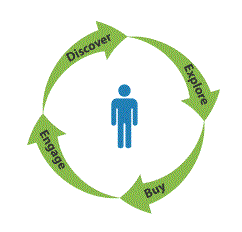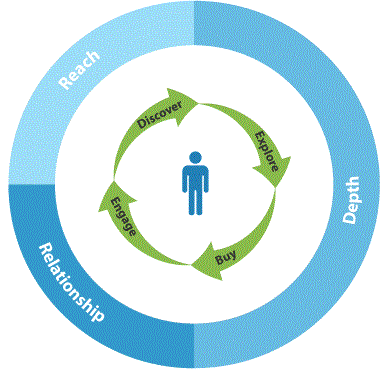Introducing the Marketing RaDaR
In our new report “Mix Art And Science For Marketing Success,” we introduce a new model: The Marketing RaDaR. This model (which serves as an update to our previous ‘interactive brand ecosystem‘ model) is designed to help you build marketing programs and strategies that support your customers all the way through the customer life cycle — and is based on data we’ve collected about which channels they use at each step of the customer journey.
I published a piece in Ad Age this week that explains the idea in more detail:
Poor Elias St Elmo Lewis. When he first described the sales funnel more than a hundred years ago, he was trying to map the path a single customer took to a single purchase. Little did he know how badly we’d one day abuse his model. In recent years some marketers have tried to weld ‘loyalty’ or ‘advocacy’ onto the bottom of the funnel, others have tried to ‘flip’ the funnel, and many have longed to bury the funnel entirely — all in an effort to find a model that better reflects the ongoing relationships between companies and their customers.
Our research shows a four-stage customer life cycle best sums up how customers interact with companies: First, customers discover a product or service; then they explore it in greater detail; next they buy the product or service; and after purchase they engage the company from which they bought, as well as with other customers. If companies create positive engagements they can drive new discovery — either by introducing existing customers to additional products or by leveraging satisfied customers to pass the word along to others.

If we take a new approach to understanding the customer journey, of course, we need to rethink how we market to customers in that journey as well. A marketer’s job is to support customers and prospects as they traverse this life cycle — and to do that they must focus on different marketing channels at different stages of the customer journey.
Most customers tell us that when they’re open to discovering new products and services, they rely on mass-reach channels like TV ads, search engines, and word of mouth. When they want to explore products in more detail, they use depth channels like marketers’ websites and retail stores. (They turn to these same channels when completing purchases.) When they want to engage with their favorite brands, they use relationship channels — signing up for email lists or loyalty programs, or liking a brand on Facebook.
If you want to support this life cycle, you’ll need to start looking at the world the way your customers do: as an ongoing sequence of reach channels, depth channels, and relationship channels.

And that’s just what savvy marketers are doing — building their “Reach and Depth and Relationship” channels into “marketing RaDaRs” that leverage all three types of channels:
- Depth channels tell your product’s story. Your website, your stores and your salespeople serve a common purpose: to give your customers and prospects the detail they’re seeking when they explore your product, and to guide them to a purchase.
- Relationship channels serve your existing customers. Most of the people who sign up for your mailing lists or follow you in social media are existing, satisfied customers. These channels aren’t about attracting new audiences or directly driving sales — they’re about staying in touch with your biggest fans.
- Reach channels get you into the consideration set. Word-of-mouth and unbranded searches are the two channels your customers use most to discover products — followed by traditional channels like TV ads and in-store displays. Your purpose for using these tools is to encourage customers to explore your offering in greater depth.

We’ve seen this thinking in action in a number of successful campaigns over the past two years. In the US, Porsche’s ‘Everyday Magic’ program built reach, depth, and relationship channels into a cohesive marketing plan that helped drive double-digit sales growth in a tough economy. Skin care brand Eucerin’s Thai marketing team built a RaDaR around its ‘Eucerin Club’ concept; it’s now outpacing competitors in this fast-growing market.
If you’re going to build your own marketing RaDaR, it’s important to keep two things in mind:
- You need to stop thinking about ‘earned, owned, and paid.’ The concept of earned, owned and paid media shook many marketers from their slumber, and helped them see a way past traditional channel-based marketing plans. But this model was never representative of the way customers used media; like ‘digital and traditional’ it’s a classification based on organizational convenience rather than on the customer journey. Our data clearly shows that customers turn to reach, depth and relationship channels at different stages of the life cycle — regardless of whether those channels are digital or traditional, or whether they’re earned or owned or paid. It’s time to put away EOP and focus on RaDaR.
- No piece of the model is naturally more important than any other. We talk to many established marketers who prefer to focus on reach channels; often, emerging marketers want to emphasize relationship channels. But each set of channels — reach and depth and relationship — take the lead at a different stage of the customer life cycle. If you focus just on one part of the model, you’ll be less able to guide your customers through their journeys.